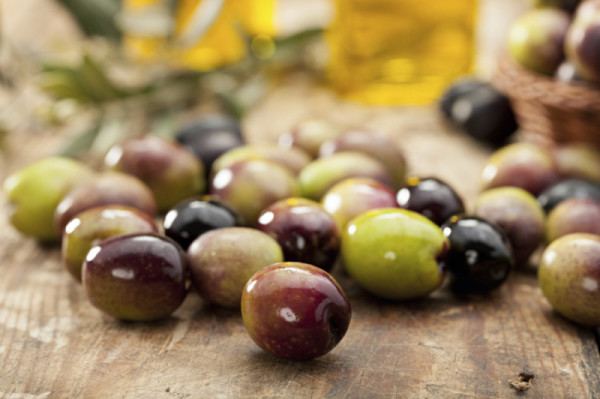
At a glance:
- Olives are an excellent source of heart-healthy oleic acid and the anti-inflammatory compounds oleuropin and hydroxytyrosol.
- Both green and black olives are superb additions to your diet.
- Olives are at risk of mycotoxin contamination. To minimize toxin exposure, choose unpitted olives that are packed in glass and have smooth, even skin.
Olives are great. They’ve been a staple for civilization after civilization as a rich source of nutrition and medicine. They’re low in toxins, high in fat, and totally Bulletproof.
Although the olive is technically a fruit, it behaves more like a vegetable. Olives are low in sugar and carbs, and they rival avocados as one of the best plant sources of fat. They reduce inflammation, fight cancer, increase testosterone synthesis, and speed up wound healing.
Olives contain several precious compounds that break down easily, so it’s important to use olives and olive oil with care when you cook. Here’s a look at those precious compounds, and how to get the most of them when you eat olives.
Olives are full of oleic acid
Olives are 15-35% fat. About 75% of that fat comes from oleic acid, which is heart protective and reduces blood pressure [1].
Oleic acid is monounsaturated, which means it’s easy to oxidize. Protect this fragile fat by buying olive oil that’s stored in dark glass and produced as close to you as possible. Because it weighs so much, olive oil comes overseas on boats, and it can be months before it makes it onto supermarket shelves. The fresher the olive oil, the more beneficial compounds and intact fats it will contain, so buy domestic when possible.
Olives are also high in vitamin E, vitamin A, and copper.
Oleuropein and hydroxytyrosol
Oleuropein is the main bioactive in olive oil. It’s what gives olive oil its pungent, distinct taste. Oleuropin is unique to olives; you won’t find it anywhere else. It pairs with hydroxytyrosol, the other big compound in olives.
Oleuropein and hydroxytyrosol give your body a serious upgrade:
- They are heart protective and reverse the chronic inflammation and oxidative stress that lead to cardiovascular disease.[2]
- They are potent antioxidants, both in vitro and in vivo. Hydroxytyrosol appears to be the stronger of the two.[3,4]
- They protect the pancreas from autoimmune damage.[5]
- They increase insulin sensitivity and have protective effects on glucose metabolism.[6]
- They enhance testosterone synthesis.[7]
- They can act as emollients for rheumatoid arthritis.[8]
- They have wound and skin-healing properties.[9]
- They are liver protective, especially in instances of liver damage or metabolic syndrome.[10, 11]
- They have promising and powerful anticancer properties.[12, 13]
How to buy and eat the best olives
Both green and black olives are great for you. The main difference between them is taste. Green olives are picked before they’re fully mature, and they tend to be brighter and milder in taste. Black olives are picked at or after maturation. They usually have a heavier, more pungent flavor.
As olives ripen their oleuropein content declines, making green olives higher in oleuropein than black olives.[14] Similarly, vitamin E increases as olives ripen, then begins to decline as they mature. There may be some minor benefits to eating green olives over black olives, but either is a superb addition to your diet.
Olives are susceptible to mold and mycotoxins, although they aren’t as big an issue in olives as they are in grains, chocolate, coffee, etc. The most common mycotoxin in olives is penicillic acid [15]. It’s not nearly as toxic as ochratoxin A or aflatoxin, but I’d still avoid it if you can.
- Buy olives that still have pits. Removing the pit during processing bruises the olive and makes it easier for molds to take over.
- Choose olives packed in glass over canned olives. Canned olives are usually older and of lower quality, and most cans are lined with bisphenol-A (BPA), a hormone-disrupting petrochemical derivative.
- Check the skin of the olives if you can, and skip batches of olives with discolored or patchy skin. This is especially important if you’re buying from an olive bar. It’s the equivalent of buying in bulk – who knows how long those olives have been sitting out there? You want smooth, sexy olives like the ones pictured above.
How to cook with olive oil
Olive oil is delicate and easy to oxidize, largely because it’s so low in saturated fat. You should never heat extra virgin olive oil, and you should keep non-virgin olive oil below 320°F. Extra virgin olive oil is great for you; just add it after you plate your food.
Check olive oil for additives, and again, get it bottled in dark glass. Clear glass lets light in and the light causes oxidation. Use your olive oil within a year, as it can go rancid. Lastly, make sure your olives aren’t packed in bad oils (vegetable, sunflower, etc.) or flavored with hidden MSG.
To recap:
- Olives are high in fat and nutrients, and low in toxins and sugar.
- Oleuropein and Hydroxytyrosol are the main bio-actives in olives and olive oil. They have antioxidant, anti-inflammatory, and anti-cancerous effects.
- Green olives have a little more vitamin E and oleuropein, but both green and black olives are great for you.
- Get unpitted olives packed in glass to minimize mold toxins.
- Don’t heat extra virgin olive oil. Add it to food after cooking instead.
- Keep non-virgin olive oil below 320°
Have a great week!
[expand title=”Click to read the complete list of references.” swaptitle=”Click to hide references.”]
- http://www.ncbi.nlm.nih.gov/pubmed/10443051
- http://www.ncbi.nlm.nih.gov/pubmed/20335636
- http://www.ncbi.nlm.nih.gov/pubmed/11746176
- http://www.ncbi.nlm.nih.gov/pubmed/10736621
- http://www.ncbi.nlm.nih.gov/pubmed/20025835
- http://www.ncbi.nlm.nih.gov/pubmed/23516412
- http://www.ncbi.nlm.nih.gov/pubmed/22901687
- http://www.ncbi.nlm.nih.gov/pubmed/19409473
- http://www.ncbi.nlm.nih.gov/pubmed/21128831
- http://www.ncbi.nlm.nih.gov/pubmed/18844257
- http://www.ncbi.nlm.nih.gov/pubmed/20335636
- http://www.ncbi.nlm.nih.gov/pubmed/17485840
- http://www.ncbi.nlm.nih.gov/pubmed/21318304
- http://pubs.rsc.org/en/Content/ArticleLanding/1995/P1/p19950001519
- http://www.ncbi.nlm.nih.gov/pubmed/3079463
[/expand]










